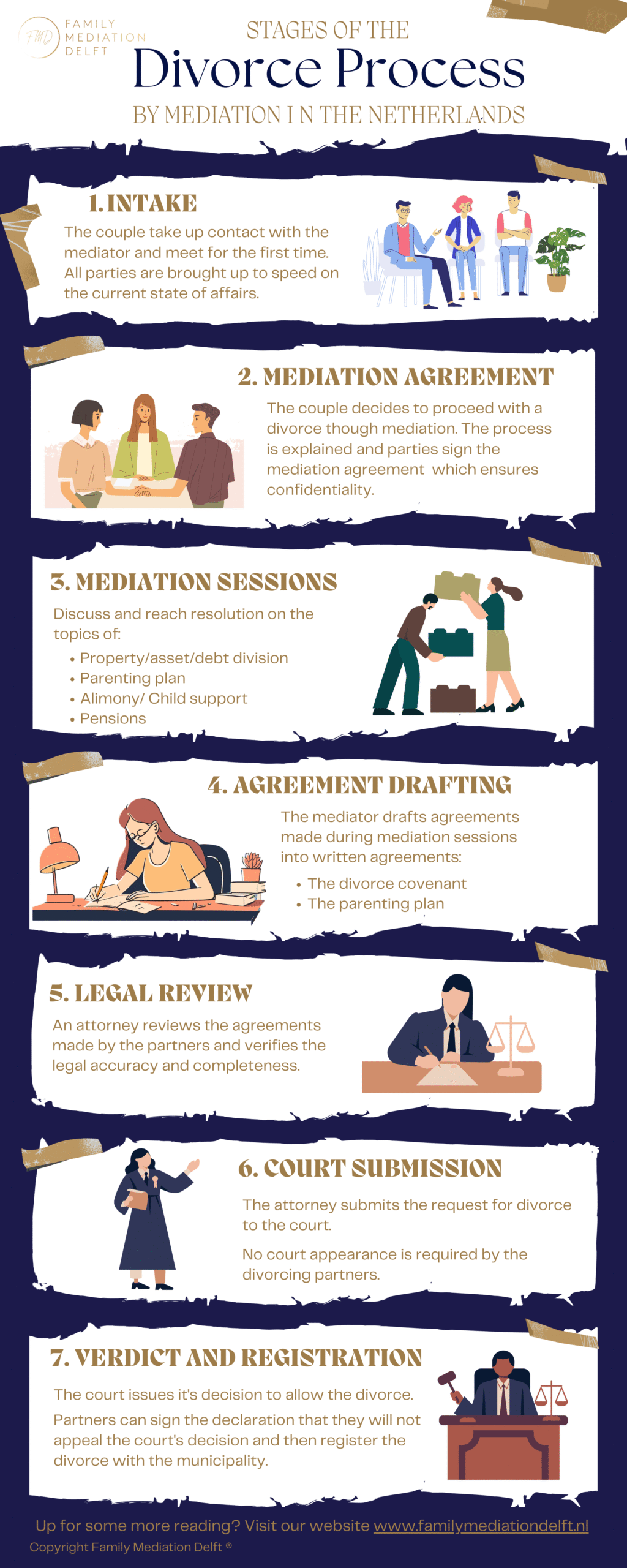Stages of the divorce process by mediation

Stages of Divorce by Mediation in the Netherlands: Step by Step
Table of Contents
Stages of Divorce by Mediation in the Netherlands; every separation is unique, but a clear and structured process can make all the difference. Mediation offers a calm, respectful space to navigate difficult decisions together, step by step.
Below is an overview of what the mediation process typically looks like, from the first conversation to the final legal steps. It’s designed to be thoughtful, transparent, and supportive throughout.
1. Intake / Initial Contact
The intake appointment is the first step in Stages of Divorce by Mediation in the Netherlands. It’s a joint conversation in a calm and neutral setting, where both partners meet with the mediator to share what’s going on and explore whether mediation is a suitable next step.
This first meeting typically includes:
An open discussion about the current situation and reasons for seeking mediation
An explanation of how the mediation process works
Space to express individual concerns, goals, and priorities
Time to ask questions and consider whether mediation feels like the right fit
The focus is on clarity, openness, and creating a respectful foundation for any future conversations.
2. Mediation Agreement
After the intake appointment, both partners take some time to reflect on whether mediation feels like the right approach. Starting mediation is a joint decision; it only begins when both people feel comfortable moving forward.
If both partners agree, the next step is to schedule the first mediation session. A mediation agreement will be shared, outlining how the process works and what everyone can expect. This helps create clarity and a sense of safety before deeper conversations begin.
3. Mediation Sessions
Once both partners have agreed to begin, the mediation sessions can start. These are structured conversations where both people sit down together with the mediator to work through the issues that need to be resolved.
Topics may include:
-
Parenting arrangements
-
Housing and finances
-
Communication and future co-parenting
-
Practical steps toward separation or divorce
Each session is designed to create space for honest dialogue, careful listening, and finding workable solutions; step by step, at a pace that feels manageable. The mediator guides the conversation and helps keep things respectful, focused, and balanced.
The number of sessions depends on what needs to be discussed and how things unfold. The aim is always to support constructive decisions that work for everyone involved, especially if there are children.
4. Agreement Drafting
Once mutual understanding and decisions have been reached in mediation, the next step is to put those agreements into writing since this helps ensure that everything discussed is clear, practical, and ready to be used in any legal or administrative steps that follow.
Depending on what’s needed, the mediator can prepare:
-
A parenting plan
-
A separation agreement
-
Financial arrangements
-
Any other practical agreements made during the sessions
The written documents reflect the outcomes of the conversations; nothing more. Each partner has the chance to review the draft carefully, ask questions, and suggest changes before anything is finalized.
5. Legal Review
A lawyer reviews the written agreement to ensure it meets legal standards and is ready to be submitted to the court.
This review helps to:
-
Confirm that the agreement is complete, fair, and legally sound
-
Clarify any legal consequences or responsibilities
-
Prepare the agreement for court approval or inclusion in the divorce petition
Each partner is free to seek their own legal advice, but generally the review can be handled by a single lawyer with both parties’ consent.
If needed, referrals to trusted legal professionals are provided.
Legal review is an important safeguard; it supports a smooth and secure path toward finalizing the divorce.
6. Court Submission
Once the agreement has been reviewed and approved by a lawyer, it’s ready to be submitted to the court.
This step is handled by the lawyer and marks the official start of the legal divorce process.
The lawyer prepares the necessary documents and files them with the court, along with the agreement. If everything is in order, the court will review the case and issue a divorce decision (beschikking).
There’s no need to appear in court; the process is handled entirely in writing.
This stage turns the agreements made in mediation into a legally binding outcome, closing one chapter and creating space for the next.
7. Court Decision & Registration
After the court reviews the submitted agreement, it issues an official divorce decision (beschikking). This document confirms the divorce and makes the agreements legally valid.
Before the divorce can be registered with the municipality, both partners must first sign an akte van berusting; a formal statement confirming that neither party will appeal the court’s decision. This step ensures the court decision becomes final.
Once both signatures are in place, the divorce can be registered at the gemeente. This final registration officially ends the marriage under Dutch law.
At that point, the legal process is complete. This is the last step in the stages of divorce by mediation in the Netherlands
8. Aftercare (Optional)
Even after the legal process is complete, the transition doesn’t end overnight. Separation and divorce often come with new questions, shifting emotions, and practical matters that arise over time.
Aftercare is available to offer support during this next phase. This might include:
A check-in session to reflect on how things are going
Help with adjusting agreements if circumstances change
Support around co-parenting, communication, or next steps
Referrals to other professionals if needed
A Thoughtful Ending
Once the agreements are finalised and the legal steps are complete, the mediation process comes to a close.
The aim throughout is to create clarity, reduce conflict, and support sound decision-making during a period of change.
While the formal process may be finished, support remains available if questions come up later or if circumstances shift. Follow-up sessions can be arranged as needed.
A structured and respectful process helps lay the groundwork for whatever comes next; in a way that’s practical, sustainable, and clear.
Cost for divorce by mediation at Family Mediation Delft
Would you like to know what a divorce would cost with Family Mediation Delft? Review our packages on our Pricing Page
Resources
Here are some links to more information you might find helpful.
For children of divorced families: Villapinedo – Life with divorced parents.
The divorce process at FMD: Divorce Applications
Contact
Is some of this information incomplete or unclear?
Do you have a different question you’d like help with?
We’re specialised in expat divorces and we’re here to help, please write us at info@familymediationdelft.nl
Would you like to try mediation? Send us an email and we’ll set up an appointment for you.
